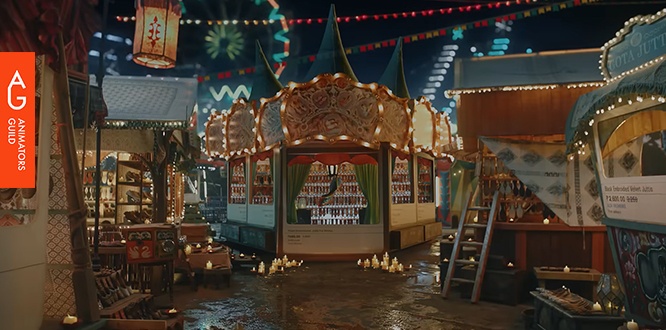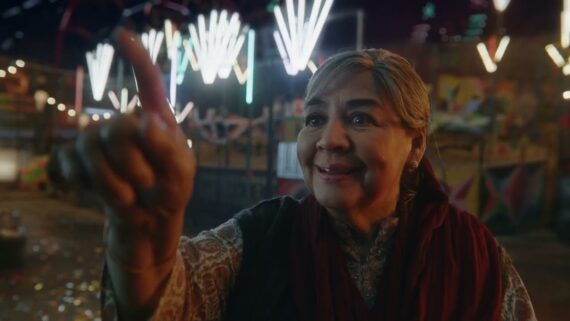Behind the Scenes of Diwali Magic: In conversation with Shapeshifter Digital

Diwali is here, filling up homes with warmth and joy — and lighting up our screens with creative campaigns and ads that capture the spirit of the season. This year, Google India has charmed audiences with their delightful campaign, "Diwali Shopping with Dadi." This heartwarming ad features some fantastic CGI scenes and 2D animation from Shapeshifter Digital. In this feature we deep dive into the creation of this piece that blends CGI mastery and nostalgic realism,
At the heart of their concept was a desire to bring the vibrancy of a Diwali Mela into an accessible, digital form. According to the team, "Achowe’s [director] brief was to create a Diwali Mela atmosphere that felt magical yet rooted in reality." To make this vision come alive, they looked to blend elements of CGI and physical design that would reflect a tactile, handmade quality.
From the outset, Isha’s storyboards and Achowe’s direction provided a clear creative foundation that aligned everyone—animators, VFX artists, set designers, and the live-action crew—around a shared vision.
Collaboration was essential to this project’s success, and fortunately, the process was smooth, thanks in part to the team’s history of working together.
Isha’s initial boards were instrumental- particularly the shop-stacking idea- which imagined a Diwali Mela assembling like a grand stage set. This approach influenced the entire project, from pre-production to the final cut. Inspired by the dramatic unfolding of Broadway sets, the team envisioned a playful, dynamic assembly, with each shop and decorative piece appearing in staggered animations: awnings unfurling, lights flickering, signs flipping, and flags fluttering.
Having most of the CG team on set proved invaluable. This decision allowed the team to capture crucial lighting references, textures, and other materials directly on set, essential for seamlessly merging live-action with CGI.
Despite several logistical issues that cropped up, the atmosphere remained supportive and solution-focused, with every team going out of their way to help one another.
They add,” The layered pre-production process was crucial given the project’s scale and complexity, as it aligned us on both creative and technical fronts well before the shoot.”
This synergy between the teams continued through post-production, where each member contributed to ensuring the final piece maintained the magic and realism they had envisioned.
Every detail of the Mela was meticulously crafted to evoke nostalgia. Hand-painted wood, patterned fabrics, string lights, and colorful flags became the foundational elements of this festive atmosphere.
While creating the elements, the team avoided an over polished look and leaned into the slight imperfections to create an organic and lived-in feel. Opting for subtle randomness and variability in how the stalls moved, adding ‘jankiness’ rather than a mechanical or overly synchronized motion and even staggering the timing of certain elements to enhance the character of the Mela- making it feel assembled by hand and full of life.
The lighting also played a critical role, with warm string lights and soft lantern glows adding depth and warmth. "We amplified the warmth and liveliness with lighting choices,” says the team, “rich, warm hues contrasted by pockets of cooler tones helped create a balanced, festive atmosphere.” This effect was also enhanced by atmospheric fog, creating a depth that mirrored the inviting charm of an actual Mela.
We strive to set up as much as possible in previs, often going the extra mile to map out multiple options and versions early to reduce experimentation during production.
“For this project, we created a series of lit previs versions to illustrate how the lighting might interact with animated and CG elements. Ideally, we also worked on a bit of a techvis—plugging in real-world camera and lens data, set dimensions, and any camera rig specifications”, they add.
On set, the team scanned the shops with tools like Polycam and Reality Capture and gathered extensive textures and prop references for later use in CG. They also recorded detailed lens and camera data for each shot, which were essential for accurate camera tracking and blending the CG with live-action footage. Back in production, they used the 3D scans of the shops to block out the final shop structure. Once everyone was happy with the layout, they started modeling on Blender to ensure accurate proportions based on the scans.
These models, along with other mela assets, were then imported into Houdini, where the layout was fixed and animation was created. For the shot where the stalls stack one on top of the other, they set up procedural animation for elements like boxes, flags, and lights, while some key boxes, shoes, and the main shop movements were animated by hand. All other shop details and surrounding elements were procedurally animated.
Texturing was done in Houdini using both on-set and online images. Lighting and shading were also handled in Houdini, with rendering completed in Redshift. The team used Nuke to stabilize and clean up the footage, replacing the background and sky with CGI assets. They then composited the rendered CG with the cleaned-up live-action footage. Final renders were delivered in DPX format for color grading, along with mattes of each CG layer for additional adjustments.
We wanted each piece to move with a sense of intention and realism, yet still appear light enough to ‘float’ into position.
The team used a mix of practical sets and miniatures alongside digital enhancements, striking a balance that made the scene feel tactile and grounded.



The shot where the shops are coming together has over 4 million polygons, with all objects moving independently.
The ambitious vision came with its own set of challenges, especially in managing the vast details within each scene. Devanshu, the studios’ resident Houdini expert, had come up with an interface to toggle the visibility of multiple objects, so only the required assets were visible at any given time. This simple adjustment made a huge difference in reducing load times and enabling them to introduce details without worrying about overloading the system.

The render farm setup was also customized to manage the different moving parts of the scenes so as to prevent the system from crashing. However, the render farm went down briefly on the last day of the delivery.” Luckily, everything came back online just in time, and we got our renders out as planned, but it was a close call!” they say.


"The budget and timeline pushed us to prioritize what would have the most impact," they reflect, emphasizing that the limitations ultimately fostered creativity and resourcefulness.
We didn’t have time to get lost in endless tweaks, which sometimes can be a good thing! It forced us to make quick decisions and keep moving.
Shapeshifter’s work on this project was achieved through collaboration, careful planning, and technical skill. By weaving CGI into the live-action backdrop, they’ve created an ad that feels both magical and real- a celebration of Diwali’s charm in the digital age.
We thank the team for their time and wish them all the very best for the future. You can find the latest from the team and connect with them on the channels below.

Varun Ramanna
Varun Ramanna is a Mumbai-based creative director and artist who, for some reason, holds a Bachelor's in Environmental Biogeosciences. After transitioning from a brief musical pursuit, he embarked on a freelance animation career, working with channels like MTV, Channel V, Cartoon Network and Disney. With over a decade of experience spanning TV, film, video games, XR, web, and live installations, Varun now leads Shapeshifter, an artist-run studio working on digital content and IP development.

Devanshu Tak
Devanshu Tak is a Bangalore-based freelance 3D generalist with a background in engineering from BITS Pilani. After switching gears from engineering to pursue his passion for 3D, he's built a portfolio spanning film, TV, and games. He first connected with Varun during an internship at Dynamite Design in 2018, and they've been collaborating on various projects ever since. Alongside freelancing, Devanshu runs a community of 3D artists in India, bringing together creatives through regular meetups and workshops.

Hrushikesh Jadhav
Hi there, I am Hrushikesh, a 3D generalist from Mumbai. You could say I was drawn to storytelling from the start! Captivated by the magic behind movies and the way they pull audiences into new worlds. That passion led me to dive into 3D artistry, where I could bring my visions to life. After earning a B.Sc. in Gaming, I spent the past two years crafting 3d environments, each with its personality. A recent twist in my journey introduced me to Varun, a creative director who opened up an exciting new spectrum of art and cinematics. I’m thrilled to bring my skills and enthusiasm to fresh challenges, creating unforgettable experiences that keep audiences hooked.

Anirudh Bhattacharya
I’m Anirudh, I’m currently a 3D generalist and concept artist. I started my career as a freelance illustrator and graphic designer only a few years ago. Along the way, I dabbled in a bunch of different roles across a variety of projects, personal and professional, which steadily supplied me with experience in both 2D and 3D work. While at my last job as a designer at a production studio, around August 2024, I was introduced to Varun, who, after seeing my portfolio, proposed working with him at Shapeshifter. Recognising it as a fantastic opportunity to grow and learn, and a chance to work on some brilliant projects with a talented team of generalists, I immediately agreed.

Isha Mangalmurti
Isha is a 2D animation filmmaker and illustrator based in India. Working on a variety of projects, she has directed title sequences for feature films/web series, music videos, short films and PSAs.



